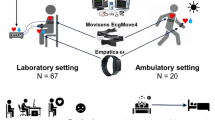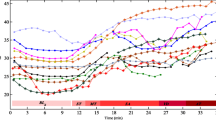Abstract
The whole-room indirect calorimeter is considered as important equipment for human energy expenditure measurement, but noise reduction in the system remains a challenge. A selective filtering method (SFM) was designed to improve the accuracy of the computation of O2 consumption rate (\( \dot{V}_{{{\text{O}}_{ 2} }} \)) and CO2 production rate (\( \dot{V}_{{{\text{CO}}_{ 2} }} \)), based on two facts: (1) the rapid changes of \( \dot{V}_{{{\text{O}}_{ 2} }} \), \( \dot{V}_{{{\text{CO}}_{ 2} }} \) and respiratory quotient (RQ) in human should be accompanied by physical activity; (2) the oxygen consumption and the carbon dioxide production should not be negative because living humans do not generate oxygen, nor consume carbon dioxide. The performance of SFM was compared with the moving average method, the central difference method and the wavelet de-noising method. The range of \( \dot{V}_{{{\text{O}}_{ 2} }} \) and \( \dot{V}_{{{\text{CO}}_{ 2} }} \) in the empty room (the background noise) is reduced from −130.00–146.00 ml/min to −26.00–24.00 ml/min, and from −20.50–12.50 ml/min to −3.99–4.19 ml/min, by SFM. The background noise was added to simulated rectangular and sinusoidal signals that were used to evaluate the four methods over different time periods (64, 32, 16 and 8 min). The highest signal-to-noise ratio and the lowest deviation were achieved by SFM. Abnormal metabolic rates and RQs were corrected and compensated with measurement accuracy of 98.51 ± 0.3 % for 24-h alcohol burning tests. The results of the study showed that SFM can significantly improve \( \dot{V}_{{\text{O}_{2} }} \) and \( \dot{V}_{{{\text{CO}}_{ 2} }} \) measurements.





Similar content being viewed by others
References
Atwater WO, Rosa EB (1899) Description of a new respiration calorimeter and experiments on the conservation of energy in the human body. Exp Stn Bull (United States Office of Experiment Stations); no 63
Beaver WL, Wasserman K, Whipp BJ (1973) On-line computer analysis and breath-by-breath graphical display of exercise function tests. J Appl Physiol 34:128–132
Brown D, Cole T, Dauncey M, Marrs R, Murgatroyd P (1984) Analysis of gaseous exchange in open-circuit indirect calorimetry. Med Biol Eng Comput 22:333–338
Brychta RJ, Rothney MP, Skarulis MC, Chen KY (2009) Optimizing energy expenditure detection in human metabolic chambers. In: Conference proceedings: annual international conference of the IEEE Engineering in Medicine and Biology Society IEEE Engineering in Medicine and Biology Society Annual Conference 2009:6864–6868. doi:10.1109/IEMBS.2009.5333121
Chavan MS, Chavan MMN, Gaikwad M (2010) Studies on implementation of wavelet for denoising speech signal. Int J Comput Appl 3
De Waele E, Spapen H, Honoré PM, Mattens S, Van Gorp V, Diltoer M, Huyghens L (2013) Introducing a new generation indirect calorimeter for estimating energy requirements in adult intensive care unit patients: feasibility, practical considerations, and comparison with a mathematical equation. J Crit Care 28:884 (e881-884. e886)
DeLany JP (2012) Measurement of energy expenditure. Pediatr Blood Cancer 58:129–134. doi:10.1002/pbc.23369
Ergen B (2012) Signal and image denoising using wavelet transform. INTECH Open Access Publisher
Graf S, Karsegard VL, Viatte V, Maisonneuve N, Pichard C, Genton L (2013) Comparison of three indirect calorimetry devices and three methods of gas collection: a prospective observational study. Clin Nutr 32:1067–1072
Granato L, Brandes A, Bruni C, Greco AV, Mingrone G (2004) VO2, VCO2, and RQ in a respiratory chamber: accurate estimation based on a new mathematical model using the Kalman–Bucy method. J Appl Physiol 96:1045–1054
Henning B, Löfgren R, Sjöström L (1996) Chamber for indirect calorimetry with improved transient response. Med Biol Eng Comput 34:207–212
Lighton JR (2008) Measuring metabolic rates: a manual for scientists. Oxford University Press, Oxford
Melzer K, Kayser B, Schutz Y (2014) Respiratory quotient evolution during normal pregnancy: what nutritional or clinical information can we get out of it? Eur J Obstet Gynecol Reprod Biol 176:5–9
Moon JK, Vohra FA, Valerio Jimenez OS, Puyau MR, Butte NF (1995) Closed-loop control of carbon dioxide concentration and pressure improves response of room respiration calorimeters. J Nutr 125:220
Murgatroyd P, Shetty P, Prentice A (1993) Techniques for the measurement of human energy expenditure: a practical guide. Int J Obes Relat Metab Disord J Int Assoc Study Obes 17:549–568
Nguyen T, De Jonge L, Smith S, Bray G (2003) Chamber for indirect calorimetry with accurate measurement and time discrimination of metabolic plateaus of over 20 min. Med Biol Eng Comput 41:572–578
Pettenkofer M (1862) Ueber die respiration. AnnlChem 123:1–52
Rumpler WV, Seale JL, Conway JM, Moe PW (1990) Repeatability of 24-h energy expenditure measurements in humans by indirect calorimetry. Am J Clin Nutr 51:147–152
Seale JL, Rumpler WV, Moe PW (1991) Description of a direct-indirect room-sized calorimeter. Am J Physiol Endocrinol Metab 260:E306–E320
Siervo M, Bertoli S, Battezzati A, Wells J, Lara J, Ferraris C, Tagliabue A (2014) Accuracy of predictive equations for the measurement of resting energy expenditure in older subjects. Clin Nutr 33:613–619
Sion-Sarid R, Cohen J, Houri Z, Singer P (2013) Indirect calorimetry: a guide for optimizing nutritional support in the critically ill child. Nutrition 29:1094–1099
Smith SW (1997) The scientist and engineer’s guide to digital signal processing
Snell B, Fullmer S, Eggett DL (2014) Reading and listening to music increase resting energy expenditure during an indirect calorimetry test. J Acad Nutr Diet 114:1939–1942
Sun M, Reed G, Hill J (1994) Modification of a whole room indirect calorimeter for measurement of rapid changes in energy expenditure. J Appl Physiol 76:2686–2691
Tokuyama K, Ogata H, Katayose Y, Satoh M (2009) Algorithm for transient response of whole body indirect calorimeter: deconvolution with a regularization parameter. J Appl Physiol 106:640–650
Weir JdV (1949) New methods for calculating metabolic rate with special reference to protein metabolism. J Physiol 109:1–9
White M, Bouchard G, Buemann B, Almeras N, Despres J, Bouchard C, Tremblay A (1996) Reproducibility of 24-h energy expenditure and macronutrient oxidation rates in an indirect calorimeter. J Appl Physiol 80:133–139
Acknowledgments
This research was supported by the National Natural Science Foundation of China (Project No. 31170900), the Beijing Natural Science Foundation (Project No. KZ201310025010) and the Ph.D. Programs Foundation of the Ministry of Education of China (Grant No. 20121107110018).
Author information
Authors and Affiliations
Corresponding author
Electronic supplementary material
Below is the link to the electronic supplementary material.
Glossary
- RQ
-
Respiratory quotient
- MR
-
Metabolic rate
- SD
-
Standard deviation
- \( \dot{V}_{{{\text{O}}_{ 2} }} \)
-
O2 consumption rate
- \( \dot{V}_{{{\text{CO}}_{ 2} }} \)
-
CO2 production rate
- \( \dot{V}_{G} \)
-
Input data set
- \( \dot{V}_{F} \)
-
Filtering data set
- SNR
-
Signal-to-noise ratio
- SFM
-
Selective filtering method
- CDM
-
Central difference method
- MAM
-
Moving average method
- WDM
-
Wavelet de-noising method
Rights and permissions
About this article
Cite this article
Quan, H., Hao, W., Li, L. et al. Algorithm to improve accuracy of energy expended in a room calorimeter. Med Biol Eng Comput 55, 1215–1225 (2017). https://doi.org/10.1007/s11517-016-1583-9
Received:
Accepted:
Published:
Issue Date:
DOI: https://doi.org/10.1007/s11517-016-1583-9




